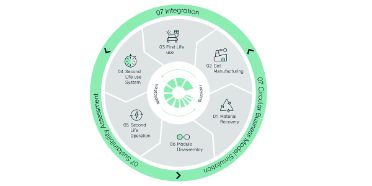CircuBAT: Swiss circular economy model for automotive lithium batteries
The research project CircuBAT aims to create a circular business model for the production, application and recycling of lithium-ion batteries used for mobility purposes.
Factsheet
- Lead school School of Engineering and Computer Science
-
Institute
Institute for Energy and Mobility Research IEM
Institute for Intelligent Industrial Systems (I3S) - Research unit IEM / Batteries and storage systems
- Funding organisation Innosuisse
- Duration (planned) 01.01.2022 - 31.12.2025
- Project management Prof. Dr. Andrea Vezzini
- Head of project Prof. Dr. Andrea Vezzini
- Project staff Viktor Franz Hangartner
-
Partner
Centre Suisse d'Electronique et de
EMPA
EPFL
Ostschweizer Fachhochschule
Switzerland Innovation Park
Universität St. Gallen
Standortförderung Kanton Bern
BKW Energie AG
Bühler AG
E-Force One AG
ESM Foundation
FPT Motorenforschung AG
Green Cubes Technology GmbH
iBAT Association
Imerys Technology Center Switzerland
Indrivetec AG
Kyburz Switzerland AG
Leclanché SA
LIBREC AG
LIDL Schweiz AG
Mobility Genossenschaft
Die Schweizerische Post AG
Schweizerische Normen-Vereinigung SNV
Société Mont-Soleil
Stiftung Auto Recycling Schweiz
sun2wheel AG
Touring Club Schweiz
Thömus AG
upVolt GmbH - Keywords Circular economy, e-mobility, sustainability, recycling, reuse
Situation
Electric vehicles are key to making mobility more environmentally friendly. Their core – the lithium-ion battery – in particular offers great potential in order to further improve their ecological balance over the entire life cycle. This is where CircuBAT comes in. Over the next four years, the research project aims to create a sustainable circular business model for lithium-ion batteries used in mobility.
Course of action
The CircuBAT project focuses on finding solutions that boost sustainability in all phases of a lithium-ion battery’s life cycle. This includes extending the lifespan of batteries during their first application. Researchers hope to achieve this by developing optimal charging and discharging strategies as well as new concepts for battery construction that make repairs easy. In addition, the project intends to put batteries to use as stationary energy storage systems after they are retired from their first mobility-related application. It therefore looks at the best ways of integrating these batteries at a local level and ensuring their safe and efficient operation. Lastly, the researchers are looking for solutions for demanufacturing batteries and recovering materials that enable large quantities of high-quality secondary raw materials to be used to produce new batteries. On top of these technical issues, the project examines socio-economic aspects and holistic business models. CircuBAT will therefore play a key role in decarbonising mobility in Switzerland and promoting the use of renewable energy.

